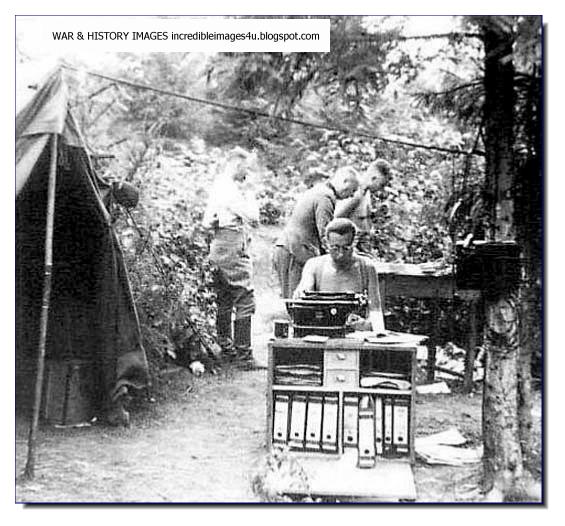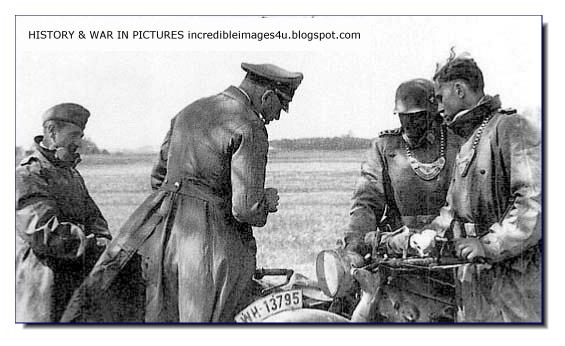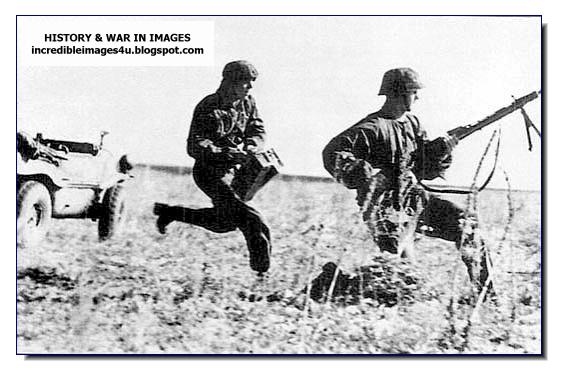"The three immense battles of Kursk, Orel and Kharkov, all in the space of two months, heralded the downfall of the German army on the Eastern Front."
Winston Churchill
By the spring of 1943 most German generals had concluded that Russia could no longer be defeated. Their aim now was to continue the fight and hope that a political pact to end the war in Russia could be reached.
BATTLE OF KURSK IN BRIEF
“This offensive is of decisive importance. It must end in swift and decisive success. Every commander, every private soldier, must be indoctrinated with awareness of the decisive importance of this offensive. Victory at Kursk will be a beacon for the whole world.”
“No offensive was ever prepared as carefully as this one.” General Mellenthin.
THE RUSSIANS PREPARE.....
VIDEO: BATTLE OF KURSK (1/2)
THE MUCH AWAITED NEW GERMAN TANKS
This time it was for the long-awaited answer to the T-34 - the PanzerKapmfWagen V - the "Panther" - and the latest creation from his favourite designer - Dr Ferdinand Porsche. The Panther was destined to be a great tank, but in July 1943 it was still suffering teething troubles, the entire stock having been issued once and recalled for rebuilding, and now re-issued to Panther Abteilung 51 and 52, totalling 200 Panthers attached to the Wehrmacht's elite "GroßDeutschland" Panzer Grenadier Division. Dr Porsche's offering was the "Elefant" - a beast of a tank destroyer, porting an 88mm gun in a fixed mounting.
Source
VIDEO: BATTLE OF KURSK (2/2)
THE RUSSIANS WERE READY....
In all this time, the Soviets had dug in - deeply on both shoulders of the salient. The immediate battle area contained up to 7 defensive lines, with dug-in anti-tank strongpoints, anti-tank ditches and millions of mines. The Soviets were also prepared in real depth for the first time: a new Front was set up - Steppe Front - based 100 Km back, including the full weight of Pavel Rotmistrov's 5 Guards Tank Army. All the units were brought back up to full - even above full - strength. The main problem this created was the numbers of new, relatively inexperienced troops in the line.
VIDEO: Battle of Kursk - Operation Citadel (Jul 1943) - Bjelgorod
BATTLE OF KURSK: A SYMPHONY FROM HELL
After the Russian victory in Stalingrad, Hitler felt that the best means of a defence against Soviet forces was a limited offence after the winter thaw. He saw the elimination of the Red Armys offensive capability as a priority in the East. Hitler had not given up his aspirations in Russia, and he was still committed to achieving his goal of taking Moscow. The large Russian forces at Kursk had to be dealt with first, and Hitler figured once he cut off the Red Army in the bulge, he would have a clear path to the Russian capital. The German Army also needed to capture men to reduce Russias fighting force and take badly needed equipment. Finally, for morale purposes, a victory at Kursk was needed to restore the Wehrmact's reputation after the Stalingrad defeat. The codename of the offensive was Citadel. Hitler went against the advice of his technical staff and decided to commit all the heavy tanks he could spare. Hitler was well aware that the operation was a huge gamble, in which defeat would cripple the German Army, but he was hoping to acquire a quick and necessary victory before the Anglo-Americans landed in the West. This gamble would not pay off though, as Hitler would make costly errors that would fatally hinder the Kursk offensive, and inevitably put an end to his dream of Lebensraum.
Problems with Operation Citadel arose from the beginning, as it was frequently postponed. The cause of the delays was due to the unfavorable terrain tied in with the slow replenishment of German forces. Since so much hinged on the offensive, Hitler did not want to engage his forces until he was completely confident. He found a source of confidence with Germany's newly developed Tiger and Panther tanks. The Soviet general, Zhukov, noted this by stating, The enemy particularly pinned his hopes on the Tiger and Panther tanks apparently believing they would stun Soviet forces and make them buckle under. Unfortunately for the German Army, the attack upon Kursk was delayed because of the slow arrival of the new tanks. Waiting for the new tanks in the end would hurt Germany more, as the all-important element of surprise was lost. The most critical mistake that Hitler and the OKW made was in its assessment of the Red Army. German high command had almost no idea that Russia was ready to assume the offensive after defending Kursk. The strong defensive position that Russia had stunned Germany, and it was this, which would lead to the critical counter attack. The Germans lack of preparation was exposed. One German corporal stated, "Our medical staff were unable to cope with all the wounded. One medical orderly told me that the dressing station was like a slaughter house to look at." Unprepared, the German Army sustained losses that they could not recover from. In soldiers alone Germany lost 500,000 men at Kursk. Hitlers plans had failed, and the threat of a renewed assault on Moscow was removed. These mistakes were not the only reason for German failure and Russian success, as it was also Russias ability to finally wage an effective war that played a key role.
Even with the victory at Stalingrad, Stalin had his doubts about whether or not Russian troops could withstand a massive German attack. This was understandable, as one victory could not erase the series of terrible losses that the Soviets had endured since 1941. Apart from Stalingrad, the Red Army had not been very successful in dealing with Germany. The situation had significantly changed by the time of Kursk though, as the Red Army was finally beginning to look like a formidable fighting force. Soviet combat strategies had improved, and Russian casualties could finally be held at supportable levels. The rate of causalities at Kursk was half that of Moscow. The Red Army was also much more prepared for Kursk then it had been in previous defensives. This was partly due to the time that Germany allowed for the defenses to be formed, but it was also due to the quality of strategy and amount of supply that Russia had. There were two defensive fronts lead by Rokossovski and Vatutin, with a vitally important reserve front under Konev in the rear. The Russian defence system was immense. There were 3 000 miles of trenches, 400 000 mines laid, and so many artillery and anti-tank guns that a curtain of fire would meet the attacking German armour. When the defence was set, there were 1 336 000 men, 3 444 tanks, 2 900 aircraft and 19 000 guns within the Kursk salient. In order to supply such a enormous force, the Red Army's logistics were truly tested. Fortunately for Russia, the Soviet war machine by this time was finally meeting the production needs. In three months prior to the battle, 500 000 railway wagons were loaded with equipment had been brought to Kursk. For the first time, the Soviet air force was well supplied. Kursk would be the first battle where the Soviets could put up more planes in the skies than the Luftwaffe. Zhukov also acknowledged the supply advantage later in his memoirs and wrote, "Although Nazi Germany continued to draw material resources from the majority of the European countries, it could no longer, after such heavy fighting on the Eastern Front, compete with the Soviet Union whose economic and military might was on the increase." With the sheer numbers and elaborate defenses, the Germans chance of success was minimal.
The German offensive began on July 5th, and already by July 10th, Rokossovski in the north held up General Kluges advance. The southern Russian section was not faring as well though, and the reserve line had to be called in. This ended any German advance in the south, and by July 12th, Kursk was a clear Russian victory. The Red Army had gambled 40% of its manpower, and 75% of its armoured forces. Like the Germans, it was a huge risk for the Soviets to take, but it would prove to be a risk worth taking. With Germany losing its last chance for success in the East, the massive Russian counter offensive could begin.
Hitlers misperception of the Red Army and its ability to mobilize for a massive counter offensive would drastically hurt the German forces chance for recovery. This, combined with Russian preparation, turned a counter attack at Kursk into a general Soviet offensive. Once the Russians held off the German attack on Kursk, Zhukov knew that the counter offensive was just around the corner as his plans were falling into place. Before the battle took place, Russian high command saw the Kursk salient as their springboard for their massive counter offensive. By July 9th, the German forces had extended themselves as far as they possibly could go. The Russian counter offensive was timed for July 12th, and when it was launched, the German attack crumbled. On July 13th, Hitler officially cancelled Operation Citadel. Zhukov and Vasilevsky then activated their plan, which was titled Operation Kutuzov. The object was to destroy German concentrations around Orel and Briansk, which would unhinge the whole German central front. The Russians were also able to launch an effective counter offensive because of their ability to repair their T-34 tanks. The Red Army did sustain heavy damage from the German attack, but they were able to repair lightly damaged tanks by the end of July. On July 5th, they had 3 800 tanks at their disposal. With heavy fighting, by July 13th, they only had fewer than 500 active tanks. This was a considerable loss, but by August 3rd with repairs, they were able to bring the number of tanks back up to 2 750. The Soviets finally had the advantage in the war, and on August 25th, Zhukov was summoned to HQ to discuss further objectives with the Soviet offensive, which was gaining significant momentum.
Both sides had taken huge military risks at Kursk, each gambling huge portions of their fighting force. The failure of Operation Citadel marked the beginning of the lengthy period of continuous retreat for the Wehrmacht. The German Reich would not be able to expand anymore in the East, and it also had to worry about guarding its western territory from the other Allies. Germany had to send fourteen divisions and other reinforcements from other fronts to the East, leaving defenses more exposed in France and Italy. Kursk turned the tide of the war, as the German Army was spread too thin. German morale was beginning to suffer, "...as by the late summer of 1943 the morale of the whole Wehrmacht from top to bottom, had suffered permanent change... hope was tainted, and humanity where vestiges of it remained, was extinguished." In Russia morale soared, as it was becoming evident that the German invaders had been stopped and were retreating. Russia made considerable gains within the year, as after five months of continuous campaigning, almost two thirds of the area occupied by Axis forces had been cleared. Hitler would only see defeat after defeat until his death in 1945.
The battle of Kursk had ended Germanys expansion and would dictated its fate in the war. It is one of the most militarily significant battle in the whole Second World War. As the largest tank battle in history, it is not only important because of the numbers of manpower and resources involved, but it critically wounded Germany beyond recovery. Hitler knew he had to gamble his Eastern forces in order to stop the Red Armys mobilization, which was starting to finally come around, before the Western Allies made their landing. Unfortunately for Germany, they made costly mistakes before the battle, while Russia was doing the opposite. Soviet production had finally increased, which contributed to the vast defence prepared and the Red Army's strategy had vastly improved. Finally, the fact that Hitler ruled out a Russian summer counter offensive from happening, was his gravest mistake. Not prepared for such a massive Russian offensive on the heels of Kursk, the Wehrmacht would begin its long retreat back to Berlin. Kursk had not immediately won the war for the Soviets and its allies, but since it was able to destroy such a large portion of the German Army in a relatively quick time, while recovering quickly itself, it could launch an immediate counter offensive that would give the Red Army the military advantage all the way back to Berlin, brining an end to the Third Reich.
Source : stalingrad_1943.tripod.com
German tank regiment being gathering for an attack.This photo gives an idea about the number of vehicles involved in the operation "Citadel".
THE WAR BEGINS.....
When the storm finally broke on 5th July, the Soviets were waiting.
The German assault started, as always, in the small hours, with assault groups moving up on the Soviet outpost lines in the North and South in the moonless night, paving the way for the main assault. The Soviets had warning of even the exact hour of the attack from a German deserter - and unleashed a massive bombardment on all the German assembly areas they could find. The attack faltered for a moment, but the main assault went in around 07:00 local time. The Luftwaffe tried once more to catch the Soviet Air Force on the ground and to annihilate them - but failed.
Noon, July 5, 1943. German soldiers advancing across the plowed fields. A few lucky people manage to get the assault gun StuG III.
In the South, the Soviets faced the remaining cream of the German military machine - 48 Panzer Corps and 2 SS Panzer Corps. The latter contained the first three SS Panzer Grenadier Divisions - LiebStandarte Adolf Hitler, Totenkopf and Das Reich. The SS formed the spearhead in the South - and managed to grind forward day-by-day, while 48 Panzer Corps tried to keep pace on their left and 3 Panzer Corps was held up on their right. The much-vaunted Panthers, attached to GroßDeutschland in 48 Panzer Corps were breaking down, catching fire, bogging in marshes - and succumbing to minefields.
HOW IT ENDED
In fact, it didn't matter - with the Soviets succesfully moving to the offensive in the North, and the invasion of Sicily a couple of days later - the German offensive was finished. The Soviets took heavy losses - but the German offensive had been stopped dead in its' tracks. This would be the last time they even tried on this scale in the East. For the Germans, the only hope after this was to try and stem the "Red Tide" - for the Soviets, it was their time to start to wreak their revenge on the invaders.
Source
Soviet airplanes attack a convoy of German vehicles. 1943
A German officer interrogates Soviet prisoners of war, hoping to learn more about the Soviet defensive positions at Kursk.
In the south, GA "Center" under the command of Field Marshal von Manstein launched an attack against Soviet troops. In the foreground a tank T-IV, firing into the Soviet positions near Dubrova.
A Panzer grenadier SS interrogates a wounded Soviet pilot. A Surgeon (right) provides first aid.
Engineering unit of the SS have built a bridge across the ditch,wile the German Tiger tanks wait to cross it
A SS man indicates the entry point of the projectile into the armor of the tank
The new German tanks: Elefant




















































































0 Comments:
Post a Comment